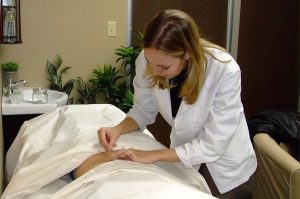Acupuncture and traditional chinese medicine
Traditional Chinese Medicine (or TCM) is a system of diagnostic techniques and treatments that have evolved over the last 3000 years. In an acupuncture treatment, fine sterilized needles are inserted through the skin and directly into the desired acupuncture channel (or meridian) in the underlying tissue. According to Chinese medicine, the normal functioning of the body depends on a balance of yin and yang energy. The flow of the body’s energy takes place along 20 lines on the body called meridians.
There are over a thousand acupuncture points along these meridians. Stimulation of these points by needles, heat, pressure, or electrical currents can correct the imbalance of energy, releasing blockages of energy and enhancing the body’s natural capacity to heal itself.
Patients’ experience of acupuncture often differs. Most feel minimal or no pain as the needles are inserted. Some people are energized by the treatment, while others report feelings of relaxation. Relatively few complications of acupuncture have been reported to the FDA. However, complications have been reported that are a direct result of inadequate sterilization of needles, and improper delivery of treatments. For this reason, it is important to seek acupuncture from a qualified practitioner.
How Does It Work?
Western scientists have found evidence that supports the theory of acupuncture points as strategic conductors of electromagnetic signals. Stimulating points along these pathways enables electromagnetic signals to be directed and relayed at a greater rate than under normal conditions. These signals may trigger the release of endorphins, and stimulate the immune system cells to become more active.
Research has also found that several types of opioids may be released into the central nervous system during an acupuncture treatment, resulting in reduced pain. Also, acupuncture can alter brain chemistry by changing the release of neurotransmitters and neurohormones, thereby positively affecting parts of the central nervous system related to sensation and involuntary body functions. Some of the processes that can be regulated in this way include blood flow, blood pressure, and body temperature.
What Is It Used For?
Acupuncture is commonly used for relief or prevention of pain. According to the American National Institute for Health, it is also a useful form of treatment for addiction, stroke rehabilitation, headache, menstrual irregularities, tennis elbow, fibromyalgia, myofascial pain, osteoarthritis, low-back pain, carpal tunnel syndrome, and asthma. There are many other general contributions of acupuncture, such as: facilitation of detoxification, decreased cravings for food or substances, relief of anxiety and nervous tension, immune system support, improved sensory function, improved concentration, improved emotional stability, and decreased inflammation.
Treatment plans
Treatment plans using acupuncture vary in length of time and frequency of treatment according to the nature of disease, patient vitality, and the intended goal of the treatment. Patients may receive treatment as frequently as 5 days a week during acute phases, after which frequency decreases progressively to once a week. Patients should receive treatment for at lease 6-8 weeks, be reassessed, and prescribed a treatment plan that will help maintain their progress and support detoxification.



